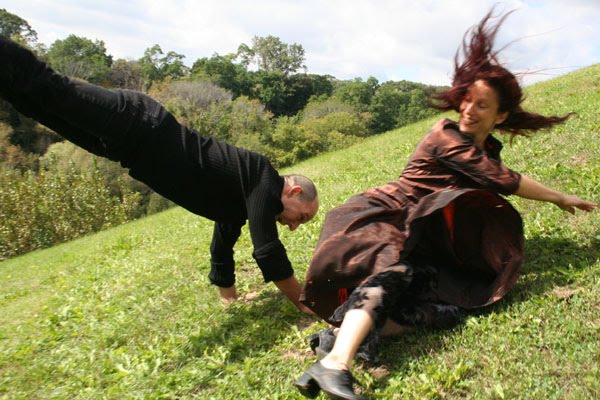GO Bus – 4:45pm
The countdown has officially begun for Nuit Blanche, Toronto’s all-night contemporary art celebration beginning tonight (September 29th). The event, co-produced by the City of Toronto and Scotiabank, is the second of its kind. Judging from the popularity of last year’s inaugural incarnation, which was visited by over 400,000 Torontonians, Nuit Blanche might be on its way to becoming a Canadian institution. The all-night art concept was initially created by the City of Paris in 2002, and four years later, crossed the ocean to be reinvented Toronto-style. I am particularly interested in what this Toronto version will hold: the city has been divided into three zones where attendees can see or interact with free art installations, exhibitions, performances and films. Artists involved in the process include videographers, painters, musicians, photographers, curators and choreographers, among others.
My mission from 7pm to 7am is to hop, skip and jump across the city to see some dancing. Plotted out on a colourful map is my itinerary, a representation of what might turn out to be an urban scavenger hunt for performances. My evening will begin in the Distillery District, where choreographer Viv Moore has curated sixteen dance performances. The list of this evening’s scavenger dance items include a group work by Sashar Zarif Dance, a duet by The Chimera Project, another duet by Emily Cheung and Gary De Matas (all in the Distillery District), work by Ame Henderson in Bellevue Square Park, by Yvonne Ng at Cecil Street Community Centre, by Karen Kaeja’s all-night creation in the Casa Loma Stables, and Viv’s own choreography on the railway tracks at the Distillery District.
I am green to the “White Night” process, so as I ride downtown I am double-checking my bag for coffee money, transit money and writing tools. My main worry at this point is staying awake, but with caffeine as my companion, I have the will to discover the treasures that this city will reveal over the next twelve hours.
Susan Cash and Sashar Zarif
Case Goods Lane, Distillery District – 7:18pm
My map leads me onto the cobble-stone streets of the Distillery District for a piece co-created by Susan Cash and Sashar Zarif in Case Goods Lane, a narrow alley illuminated by a downcast spotlight. The crowd gathers at one end where, directly behind, a female artist creates a kaleidoscopic canvas out of colorful glue and thin paper.
The performance begins with a recorded soundtrack of tenor voices singing melismatic lines (several notes sung to one syllable) against a thundering drum. Two figures emerge from a doorway etched into one of the alley’s parenthetical buildings; they are swathed in black fabric, toting a black sheet that floats over another robed figure standing between them. Making a zig-zagging path into the centre of the alley, the two dancers find their place on the ground, one burying herself and writhing under the black fabric. Later, after a fourth dancer has emerged, we see the quartet of female dancers posturing with nervous and laborious physicality, their faces desolate and their arms alternating from baby-cradling imagery to angry, fisted gestures.
The dancers’ heavy emotionality continues to mesmerize, and they allow only small glimpses of their skin before disappearing under the black of their costumes. They seem burdened, constantly withdrawn, earthbound, merged into the shadows of the black fabric. We hear them protesting with high-pitched murmurs and distressing grunts as they attempt to unwrap themselves. Finding no resolution, the dancers wander hauntingly with no sense of direction, hopelessly veering down the far side of the alley, as the air around us turns frigid. A lone dancer remains; she shapes her robe and cradles it like an infant and caresses it in the curvature of her arms, walking away from us as the applause commences.
Reflecting on this closing image, I cross this first item off my scavenger map and continue hunting.
“The Phantom Rose” by Emily Cheung and Gary De Matas
Trinity Street, Distillery District – 9:15 pm
I’m one body amongst many outside some storefront windows. On the other side is a stretch of pale wood floor, a red blot of fabric is swirled into a flower shape in its centre. The emptiness of the space beyond the windows wears heavily on the crowd knocking elbows behind me, competing for a good spot and singing angry overtures about how tall people should move back. My heart is warmed by the idea that people are so eager to see dancing that they border on the obnoxious.
A haunting waltz begins to grow as Gary De Matas and Emily Cheung enter the space. I am instantly intrigued by their animalistic intent, their intimately locked eyes and the coyness that Cheung can foster. Their limbs entwine as they creep toward the red mass of fabric, which now begins to expand. The red swathes the floor as the two movers unravel it, revealing it as a gigantic full-circle skirt. The skirt is now splayed out completely, the dancers’ fascination with it taking them underneath it to the opening in its centre. They birth through it and stand, bound at the waist by billows of red. Attached to each other at the hip, Cheung and De Matas wear the garment together, eventually swirling the red skirt into its original bud shape. Stepping out of their entangled state, the duo exist side by side, edging toward the fourth wall.
The merging of cultural dance forms in this work engages me. Cheung and De Matas incorporate their individual movement sensibilities, informed by their respective backgrounds in Chinese and Trinidadian dance to communicate through a fused physical vocabulary – a beautiful representation of this city’s varied multicultural terrain.
The Chimera Project
Tank House Lane, Distillery District – 9:30pm
A projection of a woman’s face (a separate Nuit Blanche exhibit) blankets the building behind me, hovering over us as Malgorzata Nowacka and Tim Spronk go through pre-performance motions. They dance inside a rectangular space: a strip of masking tape laid out on the street demarcates the performance area. Nowacka, aware of the time, ushers the audience backward to pre-empt any foot-to-face collisions. She explains that the masking tape on the ground is marked with terms that organize the performance: “start”, “improvisation”, “choreographed”, “improvisation” and “end”.
This information about their performance structure haunts me: I am puzzled by the fact that I cannot pinpoint where one section begins and another ends, or whether they follow the structure at all. I’m also puzzled by their schizophrenic relationship. At points it borders on violent, their seemingly dangerous partnering flings Nowacka’s limbs in unpredictable directions. At other times, they evoke a confusing passivity. A particular series of solo sequences provides a choppy denouement, with each dancer gesticulating robotically.
Even for these normally ferocious dancers (I’ve seen their work a few times in the past), the unconventional performance setting makes it difficult for them to find firm footing. The uneven street throws Nowacka, a normally grounded mover with a global sense of reach space, and she nearly takes out a few audience members. Her mid-piece cries for a soundperson to increase the music volume needlessly stifled their performance, forcing them to start the piece over. In retrospect, the need for a re-do seemed unnecessary, as the music was an electronic murmur with “techno” predictability, providing more of a pale backdrop than an essential force for the piece.
After waiting for a shuttle that finally drove by – chock-full of passengers – I dig deep into my transit fare and hail a cab.
“Open Field Study (All Together Now)” Ame Henderson, Public Recordings
Bellevue Square Park, Kensington Market – 12:15am
One awkward cab ride later, I am in a neighbourhood north of Dundas Street and west of Spadina. Quaint houses are smattered with Nuit Blanche exhibits: illuminated windows project mutating silhouettes partaking in pedestrian movement. My scavenger map brings me to Bellevue Square Park to see Ame Henderson’s “Open Field Study (All Together Now)”, an all-night performance wherein fifty performers work in shifts; a varying number of dancers perform every half hour. On my way, I am distracted by drumming, the smell of putrid fish and life-sized scrabble games in an eerie Kensington Market.
I arrive at the pitch-black park, where nine dancers retreat backward as a cluster, each carrying a dim blue light in one hand. Disjointed, awkward walking takes the dancers on a journey around the perimeter of the square. I follow suit and walk alongside them, peering into the darkness as they begin circling in migratory formations. Soon their limbs seem to become magnetized, thrown against their will by unseen elements in the space around them. I am struck by how these dancers resemble ghouls, performing dead-faced, with passive bodies. They are eerily calm.
The audience is ambiguous, contributing a steady stream of unrelated chatter, until one dancer breaks the stream of movement with an accidental fall (perhaps one of the dangers of dancing while fatigued). I am both phased and irritated by the crowd’s lack of interest, but understand that this lukewarm audience is probably meant to meander around the dancers without acknowledging them.
Although I run alongside the dancers (like a crazed fan) through grass, soil and sand so that I can better see the dancers’ movements, my interest wanes as I lose a sense of what is going on, chalking it up to a structured improvisation with random acts of choreography. I look into the distance and see the group of dancers start to engage in a discussion with a passerby, and I turn on my heel to look for a coffee agent.
“Strings Attached” by Yvonne Ng Cecil
Street Community Centre – 1:15am
Standing on Cecil Street, I am thrilled with my success so far on my scavenger hunt. I head inside the centre and ask a tuxedo-clad clown where Yvonne Ng will be performing. One toothy-grinned explanation later, I am seated at the border of a ballroom floor outlined by people scarfing down crispy rice snacks. A sculpture sits on the raised stage in front of me: two solid frames throb with taught crisscrossed wires, resembling an industrial web. I glance up to see Ng standing in stillness, dressed from neck to ankles in fuchsia. Her arms rise and sink subtly with her breath; her weight shifts minutely. I am flabbergasted by what a tiny creature she appears to be in this massive space, and I cannot tear my eyes away as she stands, confronting the sculpture.
Ng waits beside it, a soundtrack of nighttime insects, strings and creaks saturating the room. She reaches into the wires, delineating where one string ends and another begins. She becomes entangled, the wires manipulating her (or perhaps vice versa) until she is stuck, shuddering like a doomed insect caught in a web. Her fragmented, spasmodic physicality intrigues the audience that has now filled the once empty ballroom floor.
We watch as Ng masters her fragmented environment. She learns to be agile and tricky, manoeuvering around the uneven wires. She finds suspension above us, balancing at the top of this once harrowing mess of lines, looking heavenward, testing the strength of both the sculpture and herself. But soon she descends; gravity gets the better of her and pulls her dangling body ever downward. At this point I can acknowledge the internal structure of the piece: discovery, mastery and then, defeat. After finding her way to the ground, she retreats out of the wired mess in an apologetic kneel. There is a collective sigh as she has made it out alive.
The crowd is loud.
A Stranger’s Account of “Bird’s Eye View” by Karen Kaeja and Diana Groenendijk
St. George Bus Stop – 3:30am
I’m sitting on a bright red bench with my now dog-eared map, trying to find some alternate way to get to Karen Kaeja and Diana Groenendijk’s co-directed dance installment, “Bird’s Eye View”, at the Casa Loma Stables. What was to be a brief sojourn across a few subway stops has turned into a fiasco, my transit plans unexpectedly cut off at the knees. Commuters are being ordered off the trains at St. George station with the information that no more northbound trains will be operating. TTC representatives are in a panic, begging for a supervisor. I wait for a bus for over an hour, my will to stay alert vanishing. I end up in conversation with the man sitting next to me, a lively Frenchman, who gives me a play-by-play of the dance events he has seen. Incidentally, his list is long and at the end of his commentary he mentions Casa Loma. Perking up, I ask him to give me all of the vivid details.
Admitting that he’s not a contemporary dance connoisseur, he still decides to take the leap and describe the Casa Loma dances. I lean forward with interest as he describes a thick wall of mist animated with a projection of dancers’ bodies and relates the experience of crossing through this wall of mist to get to the heart of the performance. Dancers occupying stable stalls moved with a kind of “individual expression” that this gentleman beside me couldn’t put his finger on. The excitement in his voice and the animated dancing of his eyebrows as he speaks give me a good picture. He says he was riveted, that it had a surreal emotional impact on him that greatly contrasted the tango he had seen earlier in the evening.
I latch onto this description as I wait, thinking about my incomplete scavenger hunt and the treasures I will miss. I realize that my journey will have to end here, and that Casa Loma and Viv Moore’s piece will have to remain unknown destinations on my map.
Although my TTC daypass is useless, my cab fare is long gone and I can barely keep my eyes open, I have an odd sense of accomplishment for making it this far. It occurs to me now that my failure to track down everything on my list may point to the success of the Nuit Blanche concept. There is far too much to see in one evening but what I did see was fascinating and contributes to a desire for more, a desire that will no doubt bring me back next year, along with hundreds of thousands of others.
Tagged: Festival, Performance, Various, ON , Toronto




